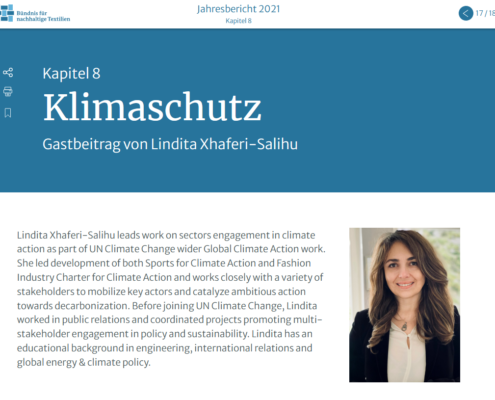Xhaferi-Salihu: Climate transition as risk and opportunity
Xhaferi-Salihu: Climate transition as risk and opportunity

Lindita Xhaferi-Salihu leads the work at the United Nations on the engagement of various industries for climate protection. She also played a leading role in the Fashion Industry Charter for Climate Action. At the Textile Partnership working meeting in May 2022 , she participated as one of six experts in the panel discussion “Mitigating climate risks in the textile and garment industry: How to achieve the 2030 goals of the Fashion Industry Charter for Climate Action“.
Below you can read excerpts from her guest article in the Textile Partnership Annual Report 2021. The full article can be found in the online Annual Report 2021.
Over the last three years, it became apparent that many organisations in the textile sector were intensifying their climate protection efforts. More and more companies focused on energy efficiency, renewable energy and low-carbon logistics. Others have set targets for low-carbon materials and are focusing on circular economy and regenerative agriculture.
Xhaferi-Salihu observes many innovations, but also points out that these have not yet taken place on a large scale and that the efforts of individual actors are not sufficient to achieve the necessary substantial changes.
These changes required great leaps in energy efficiency, renewable power generation and the development of cutting-edge technologies. Xhaferi-Salihu points out that more and more solutions are emerging and companies should consider all available tools and use those that are best suited for them.
What is needed is an "inclusive multilateralism". By this, the expert means mutually reinforcing intersections between all actors involved. She sees this as perhaps the only chance to advance ambitions that will lead to the implementation of the Paris Agreement and the SDGs:
"This sector can do so much to not only take direct climate action but influence the action of others. The Paris Agreement shows that we, as a people, as humanity, should and can work together towards positive change. But we must all work together to make it happen – in all parts of society and in all parts of the world for the benefit of all people for generations to come."
Climate protection and adaptation are associated with considerable costs. In the long run, however, these expenses pay off. This insight is also gaining ground in the financial world - in favour of companies that have a plan for low-carbon and resilient development. Xhaferi-Salihu's urgent appeal: the fashion industry must seize this opportunity.
You can find the whole article in the online Annual Report 2021.



